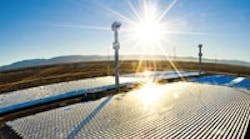September swept in with good news for Solyndra Inc. The manufacturer of cylindrical solar photovoltaic panels was announced as the recipient of a $535 million loan guarantee from the U.S. Department of Energy to finance construction of the first phase of its second solar panel manufacturing facility.
This loan guarantee is the first issued under the American Recovery and Reinvestment Act. Vice President Joe Biden, who announced the loan finalization, identified it as "part of the unprecedented investment this administration is making in renewable energy."
Solar projects seem to make news almost daily. Just ahead of the Solyndra announcement, for example, eSolar in August unveiled its 5-megawatt Sierra SunTower solar power plant, and Solient Energy opened a pilot production facility capable of producing 1 megawatt of solar panels annually, the company said.
In the United States more than 62,000 new solar thermal and solar electric installations were completed in 2008, up 16% over the previous year, according to the Interstate Renewable Energy Council. On a global scale, capacity is expected to boom in 2009. Research firm DisplaySearch has forecast solar cell manufacturing capacity growing by 56% in 2009.
That capacity growth has a potential downside. DisplaySearch forecasts a 17% drop in PV module demand in 2009, with a recovery beginning in 2010. For now that means "the PV industry is currently experiencing an enormous over-supply that is causing rapid price erosion and potentially setting the stage for the failure of multiple cell manufacturers," says Charles Annis, DisplaySearch vice president of manufacturing research.
With more than 24,000 mirrors, eSolar's Sierra SunTower solar power plant in Lancaster, Calif., produces electricity for Southern California Edison.
Meanwhile, solar company SkyFuels has teamed with the National Renewable Energy Laboratory (NREL) to develop the SkyTrough Parabolic Trough Solar Concentrating Collector. Designed for utility-sized power generation, this innovation allows SkyTrough to reduce installed costs by 35%, according to the NREL. And at Kansas State University, professor Ryszard Jankowiak has received a grant to study photosynthetic complexes from a type of bacteria. The research could one day aid in the development of devices that more efficiently convert solar energy into electricity.
Lux Research says manufacturers could find new ways to lower costs and improve performance by focusing on more than simply the active semiconductor materials like silicon. "New nonactive materials are one potential way to do that -- they contribute between 15% and 48% of module cost," says Lux Research analyst Johanna Schmidtke, lead author of a report on the topic.
See Also




